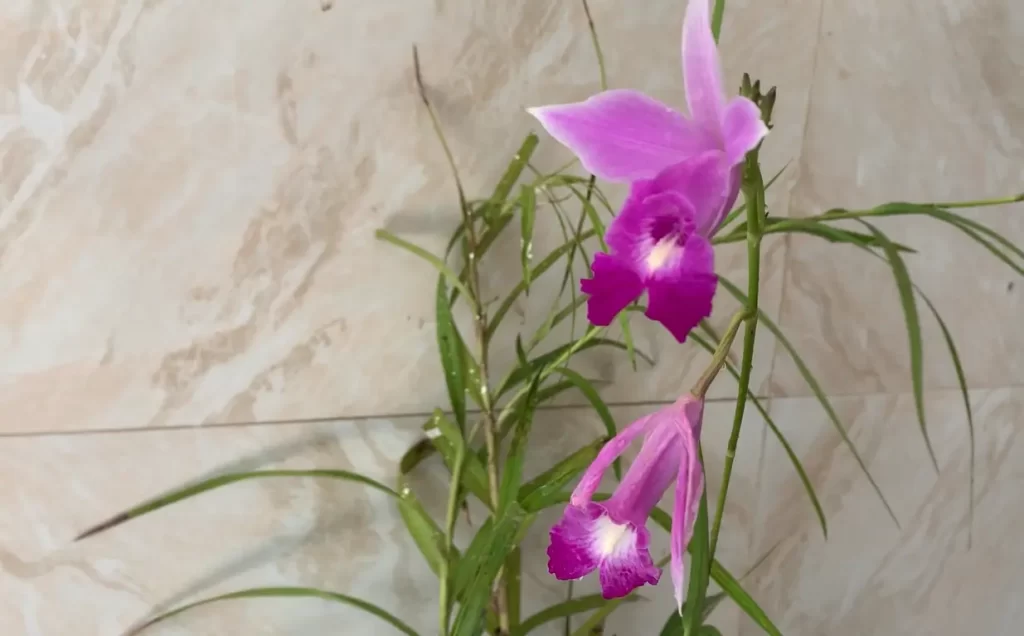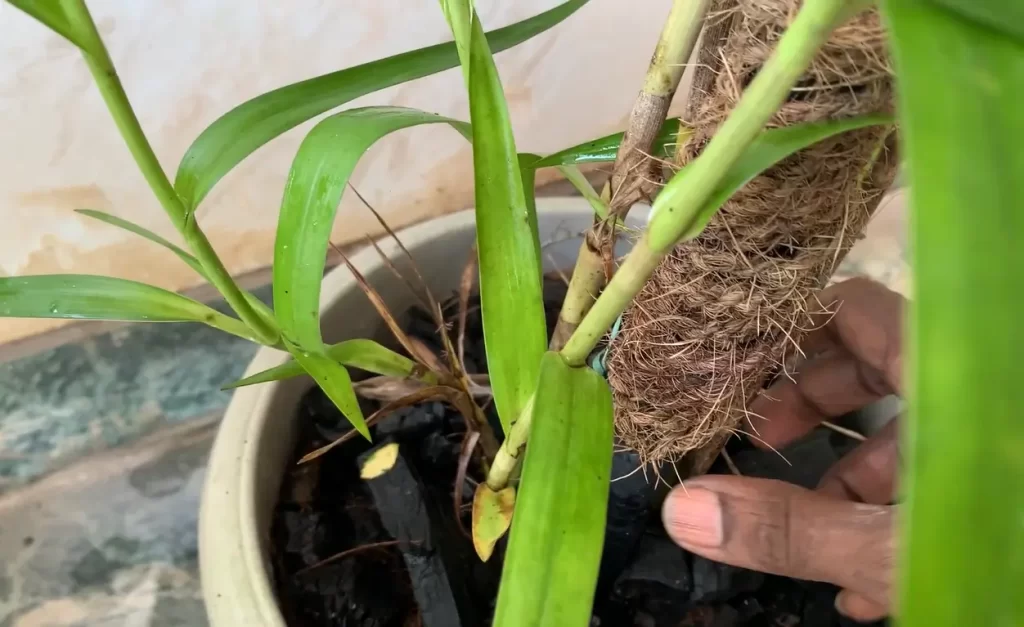How To Grow Bamboo Orchid: Everything You Need To Know
Bamboo orchids are exotic and unique plants that add a touch of elegance to any home or garden. Their graceful arching stems and stunning flowers make them a favorite among gardening enthusiasts.
While they may look delicate, bamboo orchids are surprisingly easy to grow and maintain. Now you may be wondering: How to grow bamboo orchids?
To grow a bamboo orchid, you’ll need to provide it with bright, indirect sunlight, moist soil, and warm temperatures. You will also have to fertilize it every two weeks and water it regularly.
In this guide, we will cover everything you need to know about growing bamboo orchids, from selecting the right potting mix to providing the perfect lighting conditions.
Different Varieties of Bamboo Orchids
Bamboo orchids are also known for their ease of cultivation, making them a popular choice for gardeners and hobbyists. Here, we will explore some of the different varieties of bamboo orchids.

White Bamboo Orchid
The white bamboo orchid is a popular variety of bamboo orchid that is known for its pure white petals and striking green leaves. It produces many flowers on tall spikes, making it a showy addition to any garden.
Pink Bamboo Orchid
The pink bamboo orchid is another popular variety known for its delicate pink petals. Like the white bamboo orchid, it produces many flowers on tall spikes, making it a stunning addition to any garden or indoor setting.
Yellow Bamboo Orchid
The yellow bamboo orchid is a unique variety prized for its bright yellow petals. It is often grown as a potted plant and can be used to brighten up any room in the house.
Red Bamboo Orchid
The red bamboo orchid is a rare variety prized for its rich, deep red petals. It is a striking addition to any garden and is often used as a focal point or centerpiece.
Orange Bamboo Orchid
The orange bamboo orchid is a vibrant and colorful variety that will catch the eye. It produces large, bright orange petals and can be grown indoors or outdoors, making it a versatile addition to any collection.
Purple Bamboo Orchid
The purple bamboo orchid is a stunning variety prized for its rich, deep purple petals. It is often used as a decorative plant and can be grown in pots or as part of a garden.
How To Grow Bamboo Orchids
Bamboo orchids are beautiful and unique and easy to grow and care for. These orchids are native to Southeast Asia and are known for their tall, thin stems, long leaves, and delicate flowers. If you want to grow bamboo orchids, here are some tips to help you get started.
1. Choosing the Right Pot and Soil
Bamboo orchids can be grown in pots or on the ground, but they prefer well-draining soil rich in organic matter. If you are growing your bamboo orchid in a pot, choose a pot slightly larger than the root ball of the plant. Use a well-draining potting mix rich in organic matter and good drainage.
2. Light and Temperature
Bamboo orchids prefer bright, indirect light and can tolerate some direct sunlight in the morning or late afternoon. Avoid exposing them to direct sunlight during the hottest part of the day, as this can cause the leaves to burn.
These orchids thrive in warm temperatures between 60 and 85 degrees Fahrenheit. Keep them away from cold drafts and sudden temperature changes.
3. Watering and Humidity
Water them once a week or when the top inch of the soil feels dry to the touch. Use room-temperature water, and water the plant until the excess water drains out of the bottom of the pot.
Avoid getting water on the leaves or flowers, which can cause fungal infections. Bamboo orchids also prefer high humidity levels, so consider using a humidifier or placing a tray of water near the plant to increase humidity.
4. Fertilizing
Use a balanced fertilizer with equal amounts of nitrogen, phosphorus, and potassium. Feed your orchid every two weeks during the growing season, and reduce fertilization during the winter.
5. Pruning and Maintenance
Remove dead or yellowing leaves, and trim the stems to promote new growth. You can also remove the spent flowers to encourage the plant to produce more blooms.
6. Propagation
To propagate through division, gently separate the plant into smaller sections, ensuring each section has a healthy root system. To propagate through stem cuttings, cut from a healthy stem and dip the end in the rooting hormone.
Plant the cutting in a pot filled with well-draining potting mix, and keep it moist until new growth appears.
Can I Use Orchid Soil For Bamboo?
Yes, you can use orchid soil for bamboo, but it may not be the most suitable option. Bamboo is a terrestrial plant, while orchids are epiphytic, meaning they grow on other plants instead of in the ground.
Orchid soil is typically a mix of bark, sphagnum moss, and other materials that provide good drainage and aeration for orchids’ delicate roots. However, bamboo prefers soil that retains moisture and nutrients.
You may need to amend the orchid soil with organic material or use a different type of soil to create the right growing conditions for your bamboo. Additionally, bamboo has thick, reedy stems that can grow quite tall, so make sure to choose a large planter to accommodate its size.
Does Orchid Need Special Soil?
Yes, orchids do need special soil to grow well. Regular potting soil is too dense and can retain too much moisture, leading to root rot. Orchids require a soil mix that is porous and well-draining to allow for adequate air circulation and moisture control.

A popular orchid mix comprises sphagnum moss, bark chips, and perlite. Different orchid varieties may require different soil mixes, such as terrestrial orchids that grow in the ground or reedy stemmed orchids like the Arundina graminifolia.
Additionally, orchids need consistent moisture levels and should not be allowed to dry out completely between waterings. They also require bright but indirect light and regular fertilization with a balanced fertilizer.
Frequently Asked Questions about Bamboo Orchids
Here we’ve talked about commonly asked questions about growing bamboo orchids. We hope, these answers will help you.
1. Can Bamboo Orchids Be Grown Indoors?
Bamboo orchids, or Arundina graminifolia, can be grown indoors if provided with the right conditions. They are terrestrial orchids that require bright light and consistent soil moisture. Bamboo orchids can be grown in a planter with organic soil, sphagnum moss, or cork soil. The adequate size of the planter should be considered as it can grow up to 4 feet tall with reedy stems.
2. How Often Should Bamboo Orchids Be Watered?
Bamboo orchids need plenty of water to thrive, but overwatering should be avoided. The soil should be kept consistently moist, and a misting of water can benefit the aerial roots. A bowl of water placed near the plant or a bowl of water put under the planter can help maintain consistent soil moisture. Excess water should be drained to avoid decayed roots.
3. What Is The Ideal Temperature For Bamboo Orchids?
Bamboo orchids prefer warm and humid environments. The ideal temperature for these orchids ranges from 60 °F to 90 °F (15 °C to 32 °C). They can tolerate higher temperatures during summer but should be protected from direct sunlight.
4. How Long Does It Take For Bamboo Orchids To Bloom?
Bamboo orchids are perennial orchids that bloom in the summer months. It takes two to three years for these orchids to mature and bloom. Bloom-ready size orchids can be purchased from nurseries like Wooning Orchids.
Wrapping Up
“How to grow bamboo orchid?” is a question many gardeners have asked. Growing bamboo orchid is not as difficult as it may seem. These beautiful plants can thrive in almost any environment with the right amount of sunlight, water, and soil.
To ensure success, fertilize regularly, provide adequate space for the orchid’s spreading roots, and ensure the soil is well-drained. With the proper care, the bamboo orchid can be a wonderful addition to any garden.
